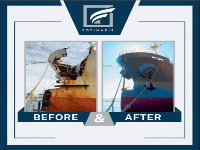Ammonia Poised to Emerge as the Leading Cost-Effective Fuel Source by the End of the 2030s, New Study Reveals
A recent publication by the Getting to Zero Coalition and the Global Maritime Forum reveals that the International Maritime Organisation (IMO) has introduced policy measures that could significantly accelerate the shift towards zero-emission fuels in shipping. Though, for these ambitious plans to truly take off, they must incorporate ample incentives and progressively stricter penalties for those who fail to comply.
The report titled ‘IMO’s policy measures: What’s next for shipping’s fuel transition?’ leverages total cost of ownership (TCO) modeling from UMAS and UCL, along with insights from over 30 industry stakeholders. It examines how capital investments and operational strategies will evolve following the IMO’s implementation of global fuel intensity (GFI) factors alongside penalties for non-compliance. This initiative positions shipping as a pioneer in establishing worldwide greenhouse gas regulations and emissions pricing.
Currently, there are various compliance routes available; however, as GFI requirements tighten and penalties increase, there’s a clear trend favoring scalable zero-emission fuels. This shift is expected to steer the industry away from traditional fossil fuels like liquefied natural gas (LNG), moving rather toward e-fuels derived from green hydrogen.
The analysis indicates that while e-fuels hold meaningful promise for achieving long-term decarbonization goals in shipping, early adoption and development of their supply chains are crucial if they are to become commercially viable soon enough.
Jesse Fahnestock, director of decarbonisation at the Global Maritime Forum, emphasized this point: “The IMO’s new framework marks a pivotal advancement; however, if e-fuels don’t gain competitiveness quickly enough, we risk encountering obstacles as we ramp up our decarbonization efforts.” He added that remaining inactive is no longer an option.
Looking ahead to late 2030s, ammonia is projected to be one of the most affordable options available.The findings suggest that dual-fuel vessels utilizing LNG alongside ammonia will be economically favorable until around mid-2030s when ammonia takes over as the cheapest option. Yet this affordability largely hinges on blue fuels—hydrogen produced using fossil sources with carbon capture—since synthetic e-fuels lack sufficient incentives before 2040.
According to TCO modeling results without specific rewards aimed at boosting e-fuel adoption, conventional fuels may still end up being pricier than LNG or ammonia within ten years. While LNG might offer lower costs between 2030-2035—perhaps extending into 2037 through onboard carbon capture technologies—blue ammonia is set to emerge as a leading cost-effective choice post-2037.Given these long-term investment horizons in mind today suggests ordering dual-fuel vessels capable of running on e-fuels could be wise.however, it’s essential for IMO guidelines to establish rewards ensuring these alternatives remain competitive now rather than later.
Fahnestock noted further adjustments are necessary: “When you think about future demands related to decarbonization trends today already points towards investing in dual-fuel ships designed for e-fuels being smart.” He also mentioned how evolving policies can significantly encourage investments into facilities producing such sustainable fuels.
Feedback gathered from numerous stakeholders indicates many companies prefer adopting a cautious “wait-and-see” strategy focused on short-term savings by operating existing vessels with biofuels or LNG instead of committing resources toward zero-emission technologies due mainly due regulatory uncertainties and perceived risks associated with new fuel types. Nevertheless some players are proactively pursuing long-term strategies by ordering dual-fuel ships aiming leverage them under upcoming regulations effectively
The IMO’s regulatory framework features tiered GFI targets spanning years 2028 through 2040 which includes two distinct paths: one less stringent base line categorizing undercompliance into tiers while another more rigorous direct compliance line mandates adherence avoiding penalties altogether . Shipping firms have multiple avenues available including switching fuel types paying fines via remedial units or purchasing surplus units generated by compliant vessels exceeding their targets . Additionally , ships employing near-zero emission solutions stand poised receive financial benefits although specifics remain undefined .
“We’ve established an initial regulatory structure,” Fahnestock concluded , “but ongoing refinements will be critical if we wont early-stage viability among efuels so our sector can meet its ambitious climate goals . Inaction isn’t feasible anymore but shaping rules effectively remains vital incentivizing necessary investments paving way forward maritime sustainability.”
Content Original Link:
" target="_blank">


















































